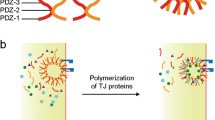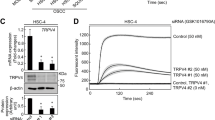Abstract
Tight junctions (TJs) regulate epithelial cell polarity and paracellular permeability. Loss of functional TJs is commonly associated with epithelial cell-derived cancers. Raf1-mediated transformation of rat salivary gland epithelial cells (Pa4-Raf1) induces transcriptional downregulation of the TJ protein occludin and forced re-expression of occludin rescues polarized phenotype of epithelial cells. In the present study, we used this model to examine how specific structural modifications in the occludin protein affect its function in vitro and influence tumor growth in vivo. Our results revealed that neither the C-terminal nor the N-terminal half of occludin alone were sufficient to rescue cells from transformation by Raf1. However, forced expression of an occludin mutant lacking the first extracellular loop was sufficient to rescue cells from Raf1-mediated transformation. Interestingly, forced expression of an occludin mutant lacking the second extracellular loop did not rescue the epithelial phenotype in vitro nor did it prevent tumor growth in vivo. These results demonstrate that the TJ protein occludin has a potent inhibitory effect on the Raf1-mediated tumorigenesis and the second extracellular loop of occludin appears to be critical for this function.
This is a preview of subscription content, access via your institution
Access options
Subscribe to this journal
Receive 50 print issues and online access
$259.00 per year
only $5.18 per issue
Buy this article
- Purchase on Springer Link
- Instant access to full article PDF
Prices may be subject to local taxes which are calculated during checkout







Similar content being viewed by others
References
Ando-Akatsuka Y, Saitou M, Hirase T, Kishi M, Sakakibara A, Itoh M, Yonemura S, Furuse M and Tsukita S . (1996). J. Cell Biol., 133, 43–47.
Balda MS, Whitney JA, Flores C, Gonzalez S, Cereijido M and Matter K . (1996). J. Cell Biol., 134, 1031–1049.
Bamforth SD, Kniesel U, Wolburg H, Engelhardt B and Risau W . (1999). J. Cell Sci., 112, 1879–1888.
Chen Y, Merzdorf C, Paul DL and Goodenough DA . (1997). J. Cell Biol., 138, 891–899.
Cobb MH, Hepler JE, Cheng M and Robbins D . (1994). Semin. Cancer Biol., 5, 261–268.
de Vries JE, ten Kate J and Bosman FT . (1996). Pathol. Res. Pract., 192, 658–668.
Furuse M, Hirase T, Itoh M, Nagafuchi A, Yonemura S and Tsukita S . (1993). J. Cell Biol., 123, 1777–1788.
Furuse M, Itoh M, Hirase T, Nagafuchi A, Yonemura S and Tsukita S . (1994). J. Cell Biol., 127, 1617–1626.
Furuse M, Sasaki H, Fujimoto K and Tsukita S . (1998). J. Cell Biol., 143, 391–401.
Gonzalez-Mariscal L, Betanzos A, Nava P and Jaramillo BE . (2003). Prog. Biophys. Mol. Biol., 81, 1–44.
Hoover KB, Liao SY and Bryant PJ . (1998). Am. J. Pathol., 153, 1767–1773.
Hopkins AM, Walsh SV, Verkade P, Boquet P and Nusrat A . (2003). J. Cell Sci., 116, 725–742.
Kimura Y, Shiozaki H, Hirao M, Maeno Y, Doki Y, Inoue M, Monden T, Ando-Akatsuka Y, Furuse M, Tsukita S and Monden M . (1997). Am. J. Pathol., 151, 45–54.
Kominsky SL, Argani P, Korz D, Evron E, Raman V, Garrett E, Rein A, Sauter G, Kallioniemi OP and Sukumar S . (2003). Oncogene, 22, 2021–2033.
Lacaz-Vieira F, Jaeger MM, Farshori P and Kachar B . (1999). J. Membr. Biol., 168, 289–297.
Lan M, Kojima T, Osanai M, Chiba H and Sawada N . (2004). Carcinogenesis, 25, 2385–2395.
Lehmann K, Janda E, Pierreux CE, Rytomaa M, Schulze A, McMahon M, Hill CS, Beug H and Downward J . (2000). Genes Dev., 14, 2610–2622.
Li D and Mrsny RJ . (2000). J. Cell. Biol., 148, 791–800.
Li D, Lin HH, McMahon M, Ma H and Ann DK . (1997). J. Biol. Chem., 272, 25062–25070.
Matter K and Balda MS . (1998). J. Cell Sci., 111, 511–519.
Matter K and Balda MS . (2003). Nat. Rev. Mol. Cell Biol., 4, 225–236.
McCarthy KM, Skare IB, Stankewich MC, Furuse M, Tsukita S, Rogers RA, Lynch RD and Schneeberger EE . (1996). J. Cell Sci., 109, 2287–2298.
Medina R, Rahner C, Mitic LL, Anderson JM and Van Itallie CM . (2000). J. Membr. Biol., 178, 235–247.
Michl P, Barth C, Buchholz M, Lerch MM, Rolke M, Holzmann KH, Menke A, Fensterer H, Giehl K, Lohr M, Leder G, Iwamura T, Adler G and Gress TM . (2003). Cancer Res., 63, 6265–6271.
Mitic LL, Schneeberger EE, Fanning AS and Anderson JM . (1999). J. Cell Biol., 146, 683–693.
Morrison DK and Cutler RE . (1997). Curr. Opin. Cell Biol., 9, 174–179.
Nakamura T, Blechman J, Tada S, Rozovskaia T, Itoyama T, Bullrich F, Mazo A, Croce CM, Geiger B and Canaani E . (2000). Proc. Natl. Acad. Sci. USA, 97, 7284–7289.
Nottage M and Siu LL . (2002). Curr. Pharm. Des., 8, 2231–2242.
Sakakibara A, Furuse M, Saitou M, Ando-Akatsuka Y and Tsukita S . (1997). J. Cell Biol., 137, 1393–1401.
Sanders SE, Madara JL, McGuirk DK, Gelman DS and Colgan SP . (1995). Epithelial. Cell Biol., 4, 25–34.
Tobioka H, Isomura H, Kokai Y, Tokunaga Y, Yamaguchi J and Sawada N . (2004). Hum. Pathol., 35, 159–164.
Tsukita S, Furuse M and Itoh M . (2001). Nat. Rev. Mol. Cell Biol., 2, 285–293.
Van Itallie CM and Anderson JM . (1997). J. Cell Sci., 110, 1113–1121.
Vogelstein B, Fearon ER, Hamilton SR, Kern SE, Preisinger AC, Leppert M, Nakamura Y, White R, Smits AM and Bos JL . (1988). N. Engl. J. Med., 319, 525–532.
Wong V and Gumbiner BM . (1997). J. Cell Biol., 136, 399–409.
Acknowledgements
We thank GT Brown and M Utech for help in manuscript preparation, A Akyildiz for technical assistance and D Hunt for both. NIH Grants DK 59888, DK64399, DK61379, DK72564 and the Crohn's and Colitis Foundation of America supported this work.
Author information
Authors and Affiliations
Rights and permissions
About this article
Cite this article
Wang, Z., Mandell, K., Parkos, C. et al. The second loop of occludin is required for suppression of Raf1-induced tumor growth. Oncogene 24, 4412–4420 (2005). https://doi.org/10.1038/sj.onc.1208634
Received:
Revised:
Accepted:
Published:
Issue Date:
DOI: https://doi.org/10.1038/sj.onc.1208634
Keywords
This article is cited by
-
Paracellular permeability and tight junction regulation in gut health and disease
Nature Reviews Gastroenterology & Hepatology (2023)
-
Tight Junctions and the Tumor Microenvironment
Current Pathobiology Reports (2016)
-
JAM-related proteins in mucosal homeostasis and inflammation
Seminars in Immunopathology (2014)
-
Co-culture Based Blood-brain Barrier In Vitro Model, a Tissue Engineering Approach using Immortalized Cell Lines for Drug Transport Study
Applied Biochemistry and Biotechnology (2011)
-
Identification of MarvelD3 as a tight junction-associated transmembrane protein of the occludin family
BMC Cell Biology (2009)



